

Undeniably, Somali pastoral women play a key role in sustaining the livelihoods and resilience of the communities they live in. Historically, Somali women are home makers. Their main roles include taking care of the family, bearing children, carrying out daily house work like cooking cleaning and fetching water, livestock keeping and the most interesting role being construction of the family home.
Somalis mainly live in the arid and semiarid lands of Somalia, Somaliland, Kenya, Ethiopia, Djibouti and Yemen. Due to recurrent draughts accelerated by the effects of climate change, Somalis keep migrating in search of water and pasture for their livestock. For this reason, women construct mobile dome shaped houses known as aqal that are easily moved from one location to the other. During migration, women dismantle and load the aqal on a camel together with other belongings.
The Aqal symbolizes the strength and value of Somali women. The house is built using natural materials such as wood, fiber, and woven mats. The bigger and stronger the house is, the more valuable a woman is considered. Therefore women put as much effort as they can to ensure they construct a big strong house. Friends often help each other during construction and this represents how Somali women live together in unity.
Pastoralists have few belongings in their houses which enables them to easily change locations. They hardly have any furniture inside the aqal other than a bed made out of hides and wood. They usually sit on woven mats which are creatively hand made by women using colourful raw materials. Mothers known as hoyoo also make food and water storage containers, baskets, incense burners, dinning utensils and other household items. In a bid to make the house more welcoming, Somali women have for decades used incense to perfume the house. The incense locally known as unsi is made by women using frankincense, myrrh, sandalwood, sugar and essential oils. It is then burnt on hot charcoal to produce a scented thick smoke. Cleanliness is valued and when entering a Somali home, people often remove their shoes.
It takes hands to build a house but only hearts can build a home. Somali women are known for their hospitality and generosity especially when it comes to sharing meals with their friends and family. It is the duty of mothers and older girls to cook and prepare food. Preparation of food includes women slaughtering goats and sheep unlike other African tribes where slaughtering is done by men. Culturally men and women eat separately. The men are usually served first as a sign of respect. The men will then leave some of the food on the plate to be eaten by the women. Other than food, women also prepare cakes and snacks such as Halwa which is a sweet made from ghee, sugar and spices.
Despite these unique roles played by Somali women in society, they are often left out. The society is male-dominated and women are underrepresented in the modern architecture profession. It’s necessary to recognize the ability of Somali women architects and promote their skills through education. Somali women have the potential to design and build better cities. Some of the world’s biggest architectural firms are actually led by women. For instance, the broad art museum in Los Angeles was designed by a female Architect, Elizabeth Diller. Meanwhile, in Tokyo, the four-story Sumida Hokusai Museum was the work of female Architect, Katsushika Hokusai. These are a few examples of how women can create amazing buildings if given the opportunity to do so. Let us give Somali women opportunities by including them in plans to build better cities such as Hargeisa, Mogadishu, Garowe, Nairobi and other cities.
Wangui Ngugi
more recommended stories
 Power Monopoly Sparks Backlash in Burao as Government Sends Mixed Signals
Power Monopoly Sparks Backlash in Burao as Government Sends Mixed SignalsConflicting Government Letters Deepen Burao Electricity.
 Khaatumo Confirms: Al-Shabaab Behind Assassination of Ethiopian Diplomat
Khaatumo Confirms: Al-Shabaab Behind Assassination of Ethiopian DiplomatLaascaanood, SOOL – The already fragile.
 Somaliland President Prioritizes Peace and Security in Landmark Parliamentary Speech
Somaliland President Prioritizes Peace and Security in Landmark Parliamentary SpeechPresident Irro’s address reflects his administration’s.
 Ethiopian Diplomat Assassinated in Lasanod: Terror Shadows Eastern Sool
Ethiopian Diplomat Assassinated in Lasanod: Terror Shadows Eastern SoolLasanod, Somaliland – April 20, 2025.

